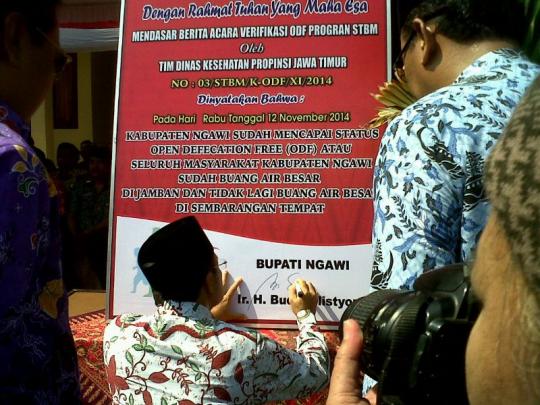
in Madiun city, East Java Province, Indonesia
Photo credit: Edy Basuki, East Java Health Office
Back in 2009, Ratih Purwindah, a 25-year-old newly appointed sanitation district facilitator, was not invited to sit in the car to travel with delegates from Indonesia’s Ngawi District to participate in the East Java province rural sanitation review meeting. Instead, Ratih was asked to take a bus the 180 km to Surabaya, even though there were vacant seats in the delegation’s car. She also did not get a desk at the district’s office. Five years onwards, this has changed and Ratih is now the provincial coordinator for the government’s sanitation program in Central Java. District sanitation facilitators working with her are recognized and empowered within District Health offices. Ratih’s personal journey is a testament to the systemic changes that have taken place in Indonesia. With a focus on district-wide sanitation service delivery, Indonesia is accelerating access from below 1% to 2-3% a year and catching up to achieve the sanitation MDG.
Ratih spent those first months in 2009 in a difficult position. In her quest to improve sanitation behaviors and reduce the practice of open defecation, she introduced a concept of “collective demand creation with no subsidy” for the community. The approach emphasizes community empowerment through collective demand creation for sanitation, leveraging products and services, and helping local governments create an enabling environment for sanitation improvement. In the eyes of some, this made her a radical thinker and disruptive force. But it didn’t take long for her disruption to net impressive gains.
signing Open Defecation Free board
Photo credit: R Hendras Prastowo,
Health Office of Ngawi
Ratih created a team of key stakeholders at the subdistrict level, such as women’s unions, health centers, boy scouts and teachers. They volunteered to work with her to ignite behavior change in the community and regularly monitor progress. Each household constructed a latrine, and more importantly, stopped the practice of open defecation and started using their newly constructed latrine. This served as a model and was quickly replicated throughout the community. This movement continued until the entire village was declared ODF. Given this experience, the district government gave full support for the program and started replicating in other villages and subdistricts.
Ratih is one of several district facilitators in East Java using this approach, part of a program implemented by the government with technical support from the Water and Sanitation Program (WSP), part of the World Bank’s Water Global Practice, from 2008 to 2011. The program increased access to improved sanitation to 1.9 million people and made 1,118 villages ODF by the end of 2014 – all without providing any financial support to individuals.
The program became a springboard for additional districts in East Java to carry out this approach with minimal support. Based on the results in East Java, the approach was adopted as the national strategy for sanitation development in Indonesia -- named Strategi Sanitasi Total Berbasis Masyarakat (STBM).
Indonesia, with 250 million people, and a member nation of the 20 biggest economic countries in the world (G-20), is the second biggest contributor to the world’s open defecation population. It is estimated that 54 million people in Indonesia are still without toilets, which contributes to an economic loss of US$6.3 billion annually or equivalent to 2.3% of GDP.
Until recently, it seemed Indonesia would not meet the MDG target for sanitation, which is to halve the number of people living without adequate sanitation by 2015. But now with a focus on behavior and creating demand, Indonesia is making ample progress and may get much closer to meeting the target than anyone believed 5 years ago. This confidence is from Indonesia’s impressive progress in the last 3 to 4 years, with sanitation access increasing on average 2 to 3% each year.
To date, more than 18,000 of 20,000 targeted STBM villages (of total 75.000 villages in Indonesia) have implemented STBM across all 34 provinces in Indonesia.
The critical factors behind this achievement are:
- Technical assistance was provided on a ‘low-cost, high-spread’ basis at a scale that mattered to policymakers -- each district in East Java was provided with technical assistance for only 8 months, with no additional financial support other than technical expertise.
- The technical support was designed to leverage local government and community funding through existing systems. Local governments in Indonesia actually do have a small allocation for sanitation – the trick was to help them redirect that to produce actual results on the ground, which they could in turn use to ask for a higher annual budget in the coming year.

with Mayors of Magetan, Madiun, Ngawi
and Pacitan (left to right) during
National Health Day celebration, November 2014
Photo credit: Edy Basuki, East Java Health Office
- Networking and gaining broad-based commitment from various key stakeholders such as national government, local district heads, media, health center staff, and communities through tailor interaction and understanding of their respective incentives for involvement was instrumental in getting results – the most successful districts literally used all potential channels and avenues they could think of to get sanitation messages across.
- Rural sanitation training has been revamped: Formal curriculae focusing on sanitation at 30 government health schools have been introduced, as part of a plan to substantially ramp up human resources to implement the national sanitation strategy. Five training modules and distance learning courses have been developed and accredited by the government. Once someone completes training they receive a certificate that is recorded with the Ministry of Health’s Human Resource Office’s database for career advancement.
- Real-time, mobile-based monitoring of progress is implemented across the country: Piloted successfully in East Java, a low-cost national web and sms-based monitoring system detailing access of sanitation from all villages has been introduced and continues to be upgraded. To date, more than 60,000 out of 70,000 villages in 32 provinces have uploaded their data regularly into the system. This upload is done by more than 4,000 sanitarians (officers in health centers at subdistrict level responsible for environmental health) via mobile phones.



Join the Conversation